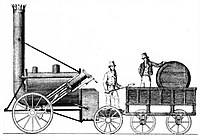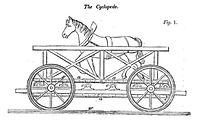Race of Rainhill


The Rainhill Race (English Rainhill Trials ) was a competition held in 1829 to determine a suitable locomotive for the Liverpool and Manchester Railway .
In the early days of the railway , the railway lines were laid as flat as possible, as was known from the construction of canals . Similar to a lock should pitches focused on short distances and there using horses or devices such as fixed steam engines or on the opposite track down moving trains , are addressed.
On the Liverpool – Manchester route, they initially wanted to do without steam locomotives and operate the 50 km long route with the help of 21 stationary steam engines. In order to test whether locomotives were also able to negotiate inclines and to find a suitable locomotive for this route, the directors of the Liverpool and Manchester Railway, at the urging of George Stephenson, organized a competition called the legendary Rainhill Trials (lit. "Rainhill tests") went down in the history of the railway .
The rules
The locomotive should pull three times its weight with a steam pressure of 50 psi (approximately 3500 hPa; 3.5 bar). It should reach a speed of at least 10 mph (16 km / h ). It should have suspension and could not be higher than 15 feet (4.5 m ). In addition, it could not weigh more than six tons . The locomotive was supposed to burn its smoke and have two safety valves , one of which had to be out of reach of the driver .
These conditions required a decisive improvement compared to the state of the art at the time, as none of the locomotives in operation up to that point could meet the conditions.
The price
The winner was to receive 500 pounds of prize money and had hopes of being able to supply the locomotives for the Manchester – Liverpool route.
The participants
Of the ten initially registered candidates, only five vehicles appeared for the race:
- The Novelty was a light two-axle machine that came from the Englishman John Braithwaite and the Swede John Ericsson .
- The Sans Pareil by Timothy Hackworth was a downsizing of the locomotives he developed and which had already proven themselves on the Stockton and Darlington Railway . It had two coupled axles . Although it was actually too heavy to meet the conditions of the competition, it was allowed to enter the competition. Many parts of the Sans Pareil, such as the cylinders , were made in the Robert Stephenson and Company machine works in Newcastle.
- The Rocket was the latest creation from George and Robert Stephenson. It had two axles , of which the front one was driven, aheatingtube boiler with an optimized enlargement of the heating surface and a standing boiler built around the fire box .
- The Perseverance by Timothy Burstall - The machine could only be moved at walking pace and therefore did not make it into the elimination.
- The Cycloped - This locomotive waspoweredby a horse using a treadmill-like mechanism. It could not reach the required speed either.
The Novelty in Mechanics' Magazine from 1829.
Contemporary depiction of The Cycloped powered by a workhorse .
The race
The various tests began on October 6, 1829 and continued until October 14. The Rocket was the only candidate to master the test track and achieved an average speed of 12.5 mph with a load that was three times its own weight. With just one car , it reached 24 mph and even 30 mph without a load, what but was not possible for a long time without carrying supplies of coal and water .
The Novelty had the lowest weight, the lowest consumption of coal, and reached the highest speed. However, as they, like the Sans Pareil, could not cope with the prescribed test track due to technical problems, the victory was awarded to Stephenson and his Rocket.
After his victory, Stephenson was allowed to deliver eight Rocket steam locomotives for the Liverpool – Manchester route. The Sans Pareil by Hackworth, whose cylinder exploded during the competition - a frequent defect in many machines at the time - was also taken over into service on the Liverpool-Manchester Railway and served there longer than the Rocket, which was shut down after a few years.
Not least because of this success, Stephenson delivered his locomotive six years later for the first regular German railway line, the Adler for the Ludwigsbahn from Nuremberg to Fürth .
Web links
- Rolf-Fredrik Matthaei: Science Museum - "Rocket" and Rainhill
- The "Sans Pareil", Locomotive Steam Engine of Mr. Ackworth, of Darlington . In: The Mechanics' Magazine . No. 325 , October 31, 1829, p. 1 (English, ANNO - AustriaN Newspapers Online [accessed on May 5, 2020]).





